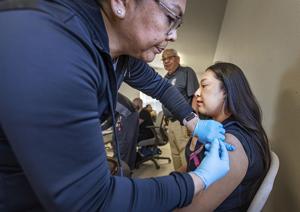Health
New Mexico Faces Choices for Federal Rural Health Funding

The New Mexico Health Care Authority is seeking input from healthcare professionals on how to allocate significant federal funding aimed at enhancing rural health services. The funding, part of the newly established Rural Health Transformation Program, totals $50 billion and is made possible through recent legislation signed into law by President Donald Trump. The state’s application for a share of these funds is due to the U.S. Centers for Medicare and Medicaid Services by November 5, 2023.
During a public forum held on a recent Wednesday, over 250 professionals from various sectors of the medical field, including doctors, telehealth developers, paramedics, and hospital executives, provided crucial feedback to officials. Participants highlighted priorities such as expanding behavioral health services, enhancing resources for mobile and telemedicine, and improving recruitment and retention of healthcare workers.
New Mexico Medicaid Director Dana Flannery expressed satisfaction with the feedback, noting that many of the priorities identified align with existing plans. “I’m very excited that a lot of what was stated today aligns with the input we’ve already received,” Flannery stated. This sentiment reflects a clear direction for the state’s application as officials prepare to utilize the funds effectively.
The Rural Health Transformation Program is a response to concerns that cuts to Medicaid and food assistance could jeopardize rural health services, potentially leading to the closure of several hospitals. The New Mexico Health Care Authority estimates that the recent budget changes could result in the closure of six to eight rural hospitals in the state by 2028. The federal initiative is designed to counteract these potential losses, providing funds that must be allocated towards specific areas, including payments to healthcare providers, chronic disease management, and technological advancements.
Of the $50 billion earmarked for this program, $25 billion will be distributed equally among all states, while the remaining $25 billion will depend on the strength of individual state applications. The New Mexico Health Care Authority is currently crafting its application for a portion of this funding, though experts caution it may not fully address the state’s rural healthcare challenges. According to analysis from the health research organization KFF, the funding represents only 37% of the anticipated losses due to Medicaid cuts in rural areas.
At the public meeting, healthcare professionals emphasized the urgent need for more staff across various roles. While specialists such as pediatricians and cardiologists are available in urban centers like Albuquerque and Santa Fe, accessing these professionals remains a challenge in rural regions. Dr. Larry Shandler, a representative from the New Mexico Pediatric Society, advocated for higher Medicaid reimbursement rates to attract more doctors to underserved areas. Earlier this year, New Mexico implemented rate increases for behavioral health, primary care, and maternal and child health services in an effort to address this issue.
The importance of enhancing telehealth infrastructure was also discussed, as it could help bridge the gap in healthcare access in remote areas. However, concerns were raised regarding internet connectivity, with the Federal Communications Commission estimating that approximately 10% of addresses in New Mexico are underserved or unserved in terms of reliable internet access.
In addition to telehealth, many attendees stressed the necessity of mobile medical resources, including paramedicine and mobile integrated health clinics. Paramedic Faith Applewhite highlighted the potential of emergency medical technicians to deliver care directly to communities, stating, “We can really be the boots on the ground to deliver that healthcare.”
As the New Mexico Health Care Authority moves forward with its application for federal assistance, securing grant funding will be essential. Flannery concluded the meeting with a call to action, urging attendees to create a competitive application that could secure vital resources for rural healthcare. “Let’s apply and have a very competitive application so that we can bring home this opportunity,” she said, emphasizing the importance of collaboration in addressing the state’s healthcare needs.
-

 Science2 weeks ago
Science2 weeks agoIROS 2025 to Showcase Cutting-Edge Robotics Innovations in China
-

 Politics2 weeks ago
Politics2 weeks agoJudge Considers Dismissal of Chelsea Housing Case Citing AI Flaws
-

 World2 weeks ago
World2 weeks agoBravo Company Veterans Honored with Bronze Medals After 56 Years
-

 Lifestyle2 weeks ago
Lifestyle2 weeks agoStone Island’s Logo Worn by Extremists Sparks Brand Dilemma
-

 Top Stories2 weeks ago
Top Stories2 weeks agoIndonesia Suspends 27,000 Bank Accounts in Online Gambling Crackdown
-

 Sports2 weeks ago
Sports2 weeks agoMel Kiper Jr. Reveals Top 25 Prospects for 2026 NFL Draft
-

 Health2 weeks ago
Health2 weeks agoStartup Liberate Bio Secures $31 Million for Next-Gen Therapies
-

 Health2 weeks ago
Health2 weeks agoTop Hyaluronic Acid Serums for Radiant Skin in 2025
-

 World2 weeks ago
World2 weeks agoHoneywell Predicts Record Demand for Business Jets Over Next Decade
-

 Politics2 weeks ago
Politics2 weeks agoNew Jersey Voters Urged to Register Ahead of November Election
-

 Lifestyle2 weeks ago
Lifestyle2 weeks agoMary Morgan Jackson Crowned Little Miss National Peanut Festival 2025
-

 Sports2 weeks ago
Sports2 weeks agoYamamoto’s Mastery Leads Dodgers to 5-1 Victory in NLCS Game 2









